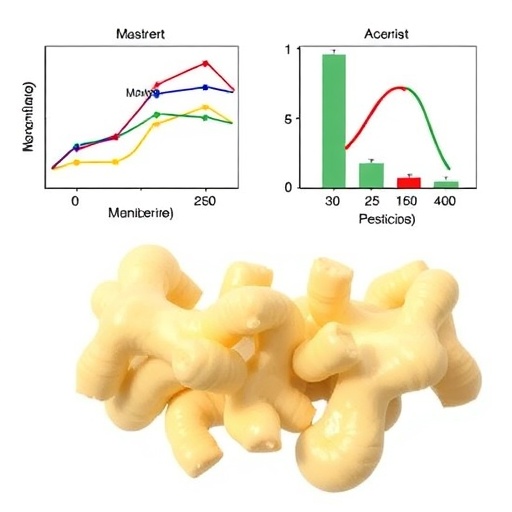In recent years, the environmental impact of pesticide use has sparked considerable concern among scientists and researchers. Among the various chemical pesticides utilized in agriculture, deltamethrin and cypermethrin have emerged as subjects of scrutiny due to their widespread application and potential toxicity. These pyrethroid compounds are known for their efficacy in pest control, but emerging studies are shedding light on their detrimental effects on non-target organisms, which could disrupt ecological balance. One promising area of research involves the understanding of how certain microorganisms, specifically the yeast strain Saccharomyces boulardii CNCM I-745, metabolically respond to these toxic compounds.
Saccharomyces boulardii is a non-pathogenic probiotic yeast that possesses unique properties for detoxifying various environmental pollutants. Researchers are increasingly investigating its potential to mitigate the adverse effects of agricultural pesticides. The study conducted by Kirmizikaya Özmen and Yilmaz titled “In Vitro Metabolic Response of Saccharomyces boulardii CNCM I-745 to Deltamethrin and Cypermethrin Toxicity” has garnered attention for its innovative approach to evaluating how this yeast can handle pesticide exposure at a cellular level.
The investigation was meticulously structured, focusing primarily on the metabolic changes that occur when Saccharomyces boulardii is exposed to sub-lethal concentrations of both deltamethrin and cypermethrin. By employing in vitro methodologies, the researchers were able to monitor how the yeast’s metabolic processes adapt or react in the presence of these toxins. The findings suggest that the yeast may possess enzymatic pathways that can effectively degrade or transform the toxic compounds into less harmful metabolites.
One of the key aspects of the study involved assessing the viability of Saccharomyces boulardii after exposure to the pyrethroids. Interestingly, it was observed that the yeast strain exhibited resilience under toxic conditions, maintaining its cellular integrity and metabolic functions. This resilience could be attributed to the yeast’s natural ability to cope with environmental stressors, making it a valuable organism for bioremediation applications in contaminated environments.
Cellular assays were a cornerstone of this research, with several biochemical markers evaluated to gauge metabolic activity and viability. The results revealed that certain metabolic pathways were upregulated when exposed to deltamethrin and cypermethrin, indicating that Saccharomyces boulardii is indeed capable of responding to pesticide stress. Such findings could pave the way for biotechnological advancements where this yeast strain is harnessed for detoxifying agricultural runoff or soil contaminated with these pesticides.
In addition to metabolic responses, the study also illustrated the potential of Saccharomyces boulardii in fostering a healthier soil microbiome. Excessive use of chemical pesticides can harm beneficial microorganisms that are essential for soil health, leading to a decline in soil fertility and increased pest resistance. By introducing this yeast into pesticide-exposed environments, it may be possible to restore balance to the ecosystem and reduce reliance on chemical interventions.
Furthermore, the implications of these findings extend beyond environmental health; they raise questions about the role of probiotics in human health as well. Since Saccharomyces boulardii is already recognized as a beneficial microorganism in the human gut, understanding its capabilities to combat environmental toxins can bolster research on gut health and external toxic exposures. The dual functionality of this yeast in both ecological and health contexts could lead to innovative therapeutic strategies.
However, despite the promising results, the researchers emphasize that further studies are needed to thoroughly understand the mechanisms behind the metabolic responses observed in Saccharomyces boulardii. Elucidating these pathways may involve advanced genomic and proteomic techniques, which could unlock further potential applications of this strain. As science progresses, the quest for sustainable and eco-friendly solutions becomes increasingly paramount, and understanding the microbial response to agrochemicals like deltamethrin and cypermethrin is a step in that direction.
This investigation sheds light on a critical intersection of environmental science and microbiology, offering insights that are directly translatable to agricultural practices and bio-remediation strategies. In an age where the consequences of pesticide exposure are becoming increasingly apparent, studies like those by Kirmizikaya Özmen and Yilmaz open doors to a greener future. By leveraging the natural power of beneficial organisms like Saccharomyces boulardii, we may find more sustainable approaches to pest control that could safeguard our ecosystems while maintaining agricultural productivity.
Such research also amplifies the call for policies that support the integration of biotechnological solutions in agriculture. The regulatory frameworks surrounding pesticide use may benefit from considering the insights gleaned from this and similar studies, leading to more informed decisions that prioritize ecological health alongside agricultural efficacy.
In conclusion, the metabolic response of Saccharomyces boulardii to pesticide toxicity presents a promising frontier in environmental research. This yeast’s ability to withstand and potentially ameliorate the toxic effects of deltamethrin and cypermethrin positions it as a key player in future agricultural practices. As scientists unravel the complexities of these interactions, there remains a broader narrative of ecological harmony, human health, and sustainable agriculture that resonates with today’s scientific endeavors.
Subject of Research: Metabolic response of Saccharomyces boulardii to pesticide toxicity
Article Title: In Vitro Metabolic Response of Saccharomyces boulardii CNCM I-745 to Deltamethrin and Cypermethrin Toxicity
Article References:
Kirmizikaya Özmen, G., Yilmaz, Ö. In Vitro metabolic response of Saccharomyces boulardii CNCM I-745 to deltamethrin and cypermethrin toxicity.
Environ Sci Pollut Res (2025). https://doi.org/10.1007/s11356-025-36927-x
Image Credits: AI Generated
DOI:
Keywords: Deltamethrin, Cypermethrin, Saccharomyces boulardii, Metabolism, Environmental Toxicology, Bioremediation, Probiotics, Agricultural Pesticides, Soil Health, Microbial Ecology.




